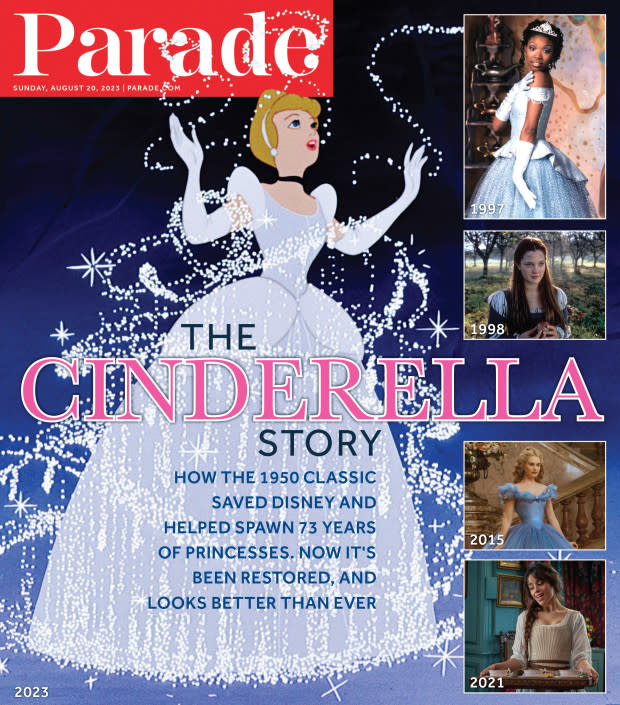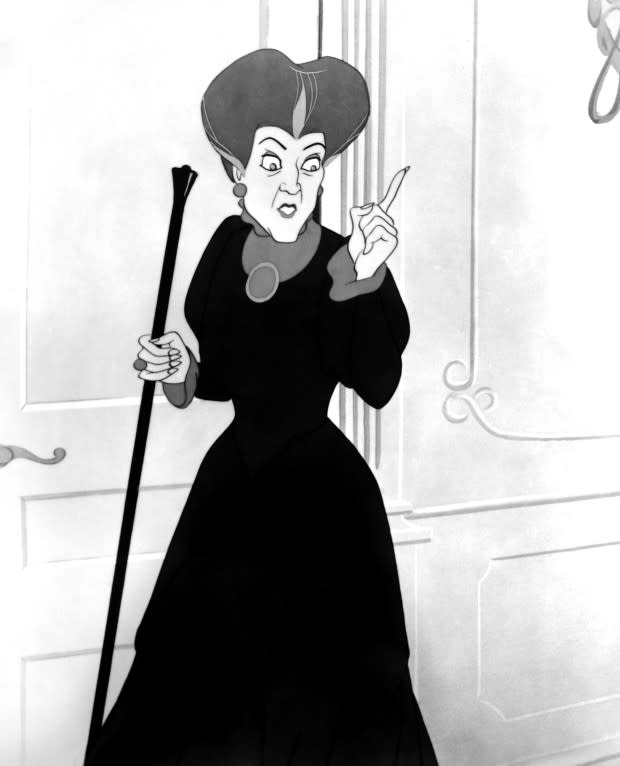How 'Cinderella' Saved Disney and Spawned 73 Years of Princesses

The 1940s were no fairytale for Walt Disney. With a war waging, many Americans didn’t have the appetite, the heart or the dollars to go to a “picture show.” Hollywood was also worried about a new competitor—television—siphoning more money from movie theaters. And then, like magic, Cinderella to the rescue! The 1950 fantasy yarn of a girl, her wicked stepsisters and evil stepmother, a dashing prince, glass slippers and a gaggle of cute, talking animals was a smashing success, right off the bat.
“Disney was on the ropes,” Turner Classic Movies host Ben Mankiewicz tells Parade. “Cinderella saved Disney.”
Coming out as the ’40s turned the corner into a new decade, the joyous fairytale was just what audiences needed, and they flocked to see it, to bask in it—a soothing big-screen balm for a nation fatigued by war and worries. Now people all over the country were chasing the American dream, longing for a new, better, more peaceful life. Yearning for something, just like the girl named Cinderella.

Parade Magazine
The movie also resonated with Walt Disney, who recognized the dream of Cinderella in his own quest to become a successful animator and head his own movie company. If she could do it, he thought, so could he. In Cinderella, Disney saw the stars align for his own future.
The movie restored Disney’s financial footing and gave his company a renewed sense of direction, paving the way for more imaginative animated tales of far-flung escapism, adventure, heroes and villains, with emotion and whimsy and heart—like Alice in Wonderland in 1951, and, in 1953, Peter Pan. Hailed at the time for its sleek look, its use of pop music in the soundtrack and its colorfully expressive characters, Cinderella is now regarded as a crown jewel in the Disney crown, one of the greatest animated stories of all time.
Years after the film, Disney remarked on why he thought it was successful—and how it did exactly what he wanted a movie to do. “I want to be hit right here in the heart,” he said. “You pulled for Cinderella. You felt for Cinderella.”
And you felt—especially later—Cinderella’s role in helping to define and enshrine what would become one of the company’s most durable cinematic trademarks: the Disney princess who finds that dreams really do come true.
“Cinderella is the definitive movie princess movie,” says Mankiewicz. “It has everything you want in a princess story, and it’s done in this authentic, beautiful way. And the bad guys get theirs.”
The “bad guys” are, of course, actually bad girls: Cinderella’s greedy, grubbing stepsisters and her awful stepmother. “Look, this movie probably is more responsible than anything else for the notion of evil, wicked stepmothers,” says Mankiewicz. “It’s not been kind to stepmothers, casting them on a very difficult road, and many of them are, of course, wonderful and important and well-meaning.”

Disney
Audiences indeed—as Disney had hoped—rooted for Cinderella; forced into servitude, unappreciated and neglected, but aided greatly by a fairy godmother and some household critters (notably mice) who help her live her dream of going to the royal ball. There she meets a handsome prince but loses one of her slippers as she’s rushing home. And when the prince finds it, he searches the realm for the woman who left it behind.
Related: 103 Best Disney Movie Quotes to Celebrate Their Famous Films
The story has resonated with people around the world for centuries. But Disney reinvented the old tale through the magic of new movie technology, using film photography of live models as templates for sequences that would later be sketched over and animated by hand. Rotoscoping, as it was called, had been developed by Max Fleischer, the pioneering animator, a few years earlier. It made characters appear, and move, with such life-like fluidity, it was almost breathtaking, like nothing anyone had ever seen before. Disney also used the technique in his animated Snow White and the Seven Dwarves and Alice in Wonderland.
Cinderella was rereleased multiple times in theaters, found repeated generations of new viewers through later release on VHS and DVD, and was eventually remade as a live-action version, starring Lily James, in 2015. And it spawned a whole slew of other “princesses."
Why does this “cartoon” tale from 1950 continue to resonate so widely? Mankiewicz thinks the answer is simple. “It was done so perfectly,” he says. “It was able to reach people, speak to them and move them. It’s got despair, perseverance and love, adorable animals…and let’s not leave out magic, very crucial magic. We want to believe in things that seem impossible, achieving things that seem inconceivable.”
Related: All Your Fave Animated Movies That Are on Disney Plus, and the 15 We Are Most Excited For
Disney’s Cinderella, he adds, “makes people think, I hope I find somebody who makes me feel the way the prince feels about Cinderella, or the way Cinderella feels about the prince. We hope we might have that ‘magic’ in our lives and find people who care about us that way. It’s not really magic, but it can feel like it.”
And the Disney magic looks better—and certainly spiffier—than ever in the new 4K rerelease of Cinderella (available Aug. 25). The 1950 movie has been meticulously restored and fine-tuned, frame by frame, into digital high resolution, some four times cleaner and more fine-tuned than a standard DVD—and more than 2,000 times sharper than an old VHS tape.
“Viewers watching this restoration will see more clarity, but they will also see more subtlety,” says veteran Disney animator Eric Goldberg, who worked on the project. “They’ll see differences in color from shot to shot and discover how one color works with another.” Surviving prints of the original film had been significantly decayed and decomposed by the years, and Goldberg adds that much care was given in the new 4K release to reinstate the vivid colors and nuanced textures of the original. “[We] knew what the film was supposed to look like, and it took a lot just ‘getting back’ to Cinderella having dusty blonde hair and a silver dress.”
From what he’s seen of the new Cinderella release, Mankiewicz is impressed. “It looks unbelievably modern and vibrant, lush and beautiful,” he says. “And if that triggers a bunch more kids to see and appreciate it, that obviously makes a lot of financial success to Disney. And there’s nothing wrong with bringing an entirely new generation of people to a movie.”
That’s impressive for a movie that’s been around for nearly 75 years—based on a tale that’s been told and retold and refashioned many times, and used as the basis for thousands of movies in dozens of languages. The character of Cinderella is much, much older than Disney—but Disney’s version remains definitive among all the other iterations of the story, across time.
And Mankiewicz reminds us why. “Disney wasn’t the first,” he says. “But they were the best.”
Next, We Ranked the 51 Best Animated Movies of All Time, From 'Snow White' to 'Soul'
